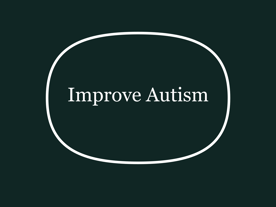A comprehensive approach to treating autism and attention-deficit hyperactivity disorder: a prepilot study
Authors:
Patel, K. and Curtis, L.T
https://pubmed.ncbi.nlm.nih.gov/18166120/
doi: 10.1089/acm.2007.0611
Summary
This study, an open-label observational prepilot investigation, examined the effects of a multidimensional treatment approach on 10 children aged 4-10 years diagnosed with both autistic spectrum disorder (ASD) (either autism or Asperger’s syndrome) and attention-deficit hyperactivity disorder (ADHD). Conducted at an environmental medicine clinic in Buffalo, New York, the study spanned 3 to 6 months and involved a comprehensive protocol combining environmental control, nutritional interventions, chelation therapy, immunotherapy, and continuation of conventional therapies (e.g., behavioral, educational, speech, and physical therapy). The 10 participants (9 males, 1 female, mean age 5.9 years) had been previously diagnosed by outside physicians or psychologists and were not on psychotropic medications during the study.
The treatment aimed to address the complex, multifactorial nature of ASD and ADHD, which often show partial improvement with standard treatments like behavioral therapy or medication. Outcomes were assessed through subjective reports from parents, teachers, and physicians, as well as objective measures such as changes in urinary heavy metal levels. All 10 children demonstrated significant improvements in social interaction, concentration, writing, language, and behavior, alongside a notable reduction in urinary lead levels. Gastrointestinal symptoms also improved, and some children transitioned from special education to regular classes. The authors acknowledge the study’s small size and lack of a control group, emphasizing its preliminary nature and the need for larger, controlled studies to validate the findings.
Key Findings
The study reported the following outcomes:
Clinical Improvements:
All 10 children showed significant improvement in multiple domains:
Social Interaction: Enhanced eye contact and social engagement.
Concentration: Improved focus and attention (average 70% improvement per parental questionnaires).
Writing and Language: Better expressive language in 8 of 10 children, plus improved writing and drawing skills.
Behavior: Reduced stereotyped movements, hyperactivity (average 46% decrease per parental reports), and behavior problems in 9 of 10 children.
Four children returned to regular classrooms from special education.
Gastrointestinal symptoms (e.g., bloating, constipation) improved in all 10 children.
Heavy Metal Levels:
Urinary lead levels decreased significantly in all 10 children (mean dropped from 48.0 to 20.3 μg/g creatinine, p < 0.001).
Reductions in urinary mercury, cadmium, and aluminum were observed but were not statistically significant.
Additional Observations:
Improvements were consistent across subjective reports from parents, teachers, and physicians.
The comprehensive approach appeared to address multiple symptoms concurrently, suggesting potential synergy among interventions.
Interventions Implemented
The multidimensional treatment protocol included the following interventions, with all supplements explicitly listed:
Environmental Control:
Avoidance of allergens, toxins, tobacco smoke, and pesticides.
Use of less toxic cosmetics and cleaners.
Mite and mold control measures.
Inspection and remediation of lead paint in homes over 30 years old.
Organic, Rotated Diet:
Low in refined sugar, free of food additives, salicylates, and artificial coloring.
Casein- and/or gluten-free for children with sensitivities.
Foods rotated on a 4-day cycle to reduce allergic reactions.
Gastrointestinal Support:
Digestive Enzymes: To aid digestion.
Probiotics: To support gut flora.
Tricycline Supplement: Containing berberine, artemisinin, citrus extract, and walnut hulls to improve gut health.
Antigen Injection Therapy:
Targeted allergies to dust mites, molds, foods, and chemicals.
Nutritional Supplements:
Vitamins:
Vitamin A
B-complex vitamins
Minerals:
Calcium
Magnesium
Manganese
Zinc
Molybdenum
Selenium
Iron
Amino Acids and Peptides:
Glutathione
N-acetyl cysteine
Taurine
Glycine
Glutamine
S-adenosyl methionine
Other Supplements:
Omega 3 fatty acids
Omega 6 fatty acids
Milk thistle
Coenzyme Q10
α-Lipoic acid
Digestive enzymes (additional to gastrointestinal support)
Probiotic bacteria (additional to gastrointestinal support)
Chelation Therapy:
Intravenous: Calcium EDTA, DMPS (2,3-dimercaptopropane-1-sulfonate), and glutathione (10-20 treatments).
Transdermal: DMPS, glutathione, ± TTFD (thiamine tetrahydro furfuryl disulfide).
Oral: DMSA (2,3-dimercaptosuccinic acid), glutathione, and α-lipoic acid.
Injections:
Glutathione and Methylcobalamin (Vitamin B12): Administered 1-3 times weekly (0.10-0.25 mL of a solution with 10,000 units methylcobalamin and 100 mg glutathione per mL).
Continuation of Usual Therapies:
Behavioral therapy
Educational therapy (special education)
Speech therapy
Occupational therapy
Physical therapy
This comprehensive approach integrates alternative and conventional strategies, targeting environmental, nutritional, and physiological factors to improve outcomes in children with ASD and ADHD. The authors advocate for further research to refine and substantiate these preliminary findings.


